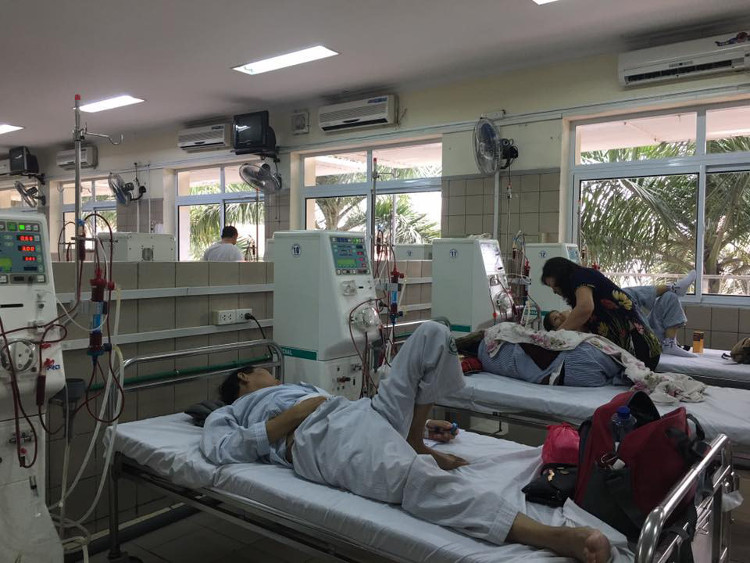Hemodialysis process
Dr. Truong Hong Son, Director of Vietnam Institute of Applied Medicine, said that the procedure of safe dialysis undergoes many stages. The patient before the most dialysis is the first time treatment with this method must be prepared from a few weeks to several months.
Before dialysis, the patient must be given a vascular access. The doctor will insert a small amount of blood into the body using a needle, run to the dialysis machine, and run from the dialysis machine into another body through another needle. The area where the needle is inserted should be fully recovered before the dialysis begins.
Currently, there are 3 ways to access the blood vessels, through venous passages (Arteriovenous (AV) fistula), through dynamic ducts - artificial veins (AV graft) , central venous lines.
'It is very carefully prepared before dialysis, such as the patient's weight, blood pressure, pulse, temperature, which are eligible to carry out this method or not. If the patient is eligible, the doctor will proceed to disinfect the blood access area , 'said Dr. Truong Hong Son.
During dialysis, the patient was taken into the 2-needle access area. Each needle is connected to an elastic tube and connected to the dialysis machine. Through a tube, the dialysis machine will filter a few milliliters of blood once, allowing waste and liquid from the blood to enter a cleansing fluid called dialysis (dialysate). The filtered blood will return to the body via a second tube.

The patient is being artificially dialysis at the Artificial Kidney Department, Bach Mai Hospital.(Photo: HQ).
Dr. Truong Hong Son said that for people who have dialysis less than 3 times / week, when blood runs out of the body, there may be symptoms of nausea, abdominal pain, this can be adjusted by asking him. Adjust the speed of dialysis, type or type of dialysis drug used. During dialysis, blood pressure and heart rate vary greatly, requiring the doctor to closely monitor.
After dialysis, the patient is withdrawn two needles from approaching the blood vessels and bandaged. The patient will be weighed again then can return to normal activities, wait until the next dialysis.
The process of implementing this method always requires the supervision of a doctor to handle unexpected situations that may occur.
Which patients will have dialysis?
According to Dr. Truong Hong Son, this method is indicated for chronic kidney patients and acute kidney damage (acute renal failure). These conditions make the kidney lose its ability to filter and remove excess fluid from the body.Hemodialysis, also called dialysis , is one of the ways to treat kidney failure.
This helps to remove residues such as urea from the blood, excess fluid from the body, maintaining electrolyte balance. These are functions that a kidney is suffering from pathology can not do.
When the patient appears the following symptoms will be indicated dialysis:
- Occurrence of signs of uremic syndrome (uremic syndrome) such as nausea, vomiting, loss of appetite, fatigue.
- Hyperkalemia.
- There are signs that the kidney is not able to remove excess fluid that may be like edema.
- Acid hyperemia.
- Pericarditis.
'Hemodialysis may be indicated for some cases of acute poisoning, before the kidneys completely lose their function and can cause serious complications,' Dr. Son said.
The process of carrying out this method can cause complications such as hypotension, cramps, nausea, vomiting, headache, chest pain, itching and chills. Less common complications are imbalance syndrome, allergic reaction (membrane reaction), cardiac arrhythmia, cardiac tamponade .
Note when dialysis for dialysis.
- Video: How dangerous will the dialysis water be?
- 7 note in eating when having dialysis patients should know
- Hemorrhage with magnet
- American scientists happen to reverse the aging process
- Video: iPhone production process
- The forgotten process is controlled in the brain by proteins
- Video: Close up of the melting process of drugs in the stomach
- Find out how to slow down the aging process
- Video: Processing process to help the Egyptian school mummy survive for thousands of years
- Gold does not naturally arise and does not lose itself, but ... falls from the sky
- Aging process - Balancing the process of new self-renewal and aging
- Determine the control area of aging in the brain
 Green tea cleans teeth better than mouthwash?
Green tea cleans teeth better than mouthwash? Death kiss: This is why you should not let anyone kiss your baby's lips
Death kiss: This is why you should not let anyone kiss your baby's lips What is salmonellosis?
What is salmonellosis? Caution should be exercised when using aloe vera through eating and drinking
Caution should be exercised when using aloe vera through eating and drinking